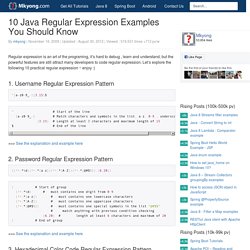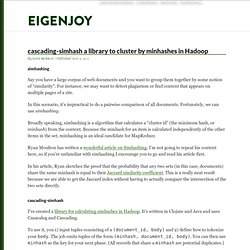

Joel on Software. 10 Java Regular Expression Examples You Should Know. Regular expression is an art of the programing, it’s hard to debug , learn and understand, but the powerful features are still attract many developers to code regular expression.

Let’s explore the following 10 practical regular expression ~ enjoy :) 1. Username Regular Expression Pattern ^[a-z0-9_-]{3,15}$ ^ # Start of the line [a-z0-9_-] # Match characters and symbols in the list, a-z, 0-9 , underscore , hyphen {3,15} # Length at least 3 characters and maximum length of 15 $ # End of the line ==> See the explanation and example here 2. ((?
( # Start of group (? ==> See the explanation and example here 3. JSch - Java Secure Channel - Examples. Biojava: A Java framework for processing biological data. NEOS Solvers. Doxygen. Generate documentation from source code Doxygen is the de facto standard tool for generating documentation from annotated C++ sources, but it also supports other popular programming languages such as C, Objective-C, C#, PHP, Java, Python, IDL (Corba, Microsoft, and UNO/OpenOffice flavors), Fortran, VHDL, Tcl, and to some extent D.

Doxygen can help you in three ways: It can generate an on-line documentation browser (in HTML) and/or an off-line reference manual (in ) from a set of documented source files. There is also support for generating output in RTF (MS-Word), PostScript, hyperlinked PDF, compressed HTML, and Unix man pages. The documentation is extracted directly from the sources, which makes it much easier to keep the documentation consistent with the source code. Doxygen is developed under Mac OS X and Linux, but is set-up to be highly portable. Doxygen license Copyright © 1997-2016 by Dimitri van Heesch.
Sponsored links(not related to doxygen) Features. Gephi is a tool for data analysts and scientists keen to explore and understand graphs. Like Photoshop™ but for graph data, the user interacts with the representation, manipulate the structures, shapes and colors to reveal hidden patterns. The goal is to help data analysts to make hypothesis, intuitively discover patterns, isolate structure singularities or faults during data sourcing. It is a complementary tool to traditional statistics, as visual thinking with interactive interfaces is now recognized to facilitate reasoning. This is a software for Exploratory Data Analysis, a paradigm appeared in the Visual Analytics field of research.
Real-time visualization Profit from the fastest graph visualization engine to speed-up understanding and pattern discovery in large graphs. Layout Layout algorithms give the shape to the graph. Metrics The statistics and metrics framework offer the most common metrics for social network analysis (SNA) and scale-free networks. Networks over time Input/Output. RandomMultivariateGen (Java Libraries for Stochastic Simulation) GrepCode: ivory.lsh.projection.ComputeSignaturesMinhash (.java) - Class - Source Code View. Cascading-simhash a library to cluster by minhashes in Hadoop. Simhashing Say you have a large corpus of web documents and you want to group them together by some notion of “similarity”.

For instance, we may want to detect plagiarism or find content that appears on multiple pages of a site. In this scenario, it’s impractical to do a pairwise comparison of all documents. Fortunately, we can use simhashing. Broadly speaking, simhashing is a algorithm that calculates a “cluster id” (the minimum hash, or minhash) from the content. Ryan Moulton has written a wonderful article on Simhashing. In his article, Ryan sketches the proof that the probability that any two sets (in this case, documents) share the same minhash is equal to their Jaccard similarity coefficient. Cascading-simhash I’ve created a library for calculating simhashes in Hadoop. To use it, you 1) input tuples consisting of a (document_id, body) and 2) define how to tokenize your body.
The library can be called from either Clojure or Java. A Java example Notice a few things here: Given: We get: